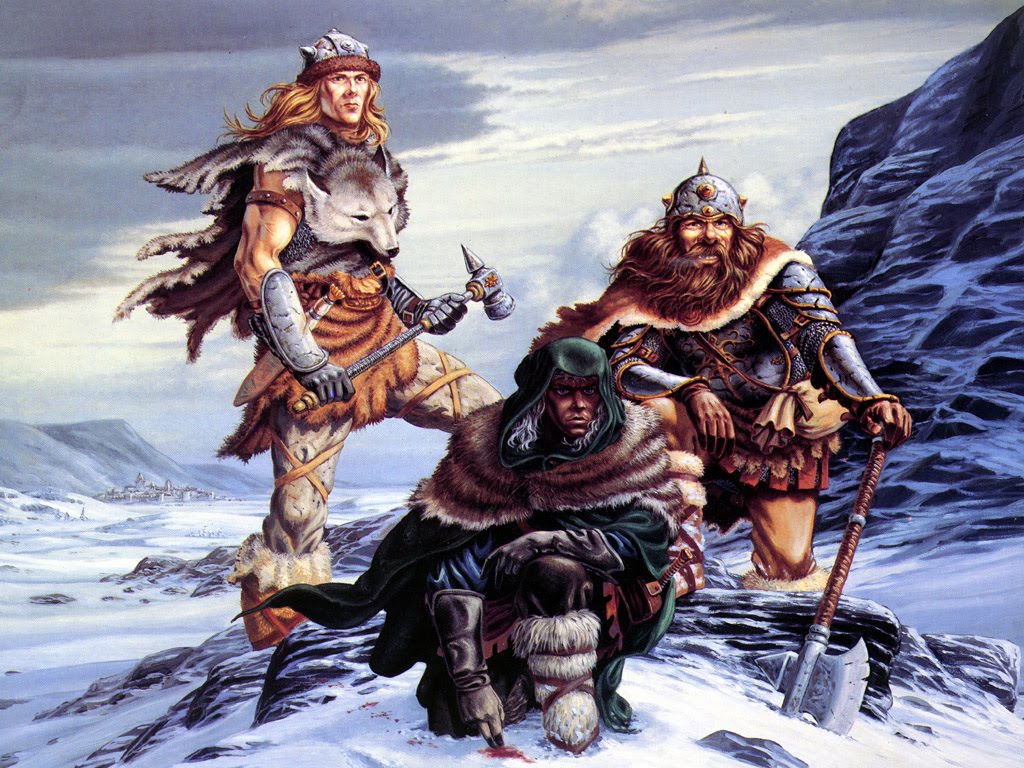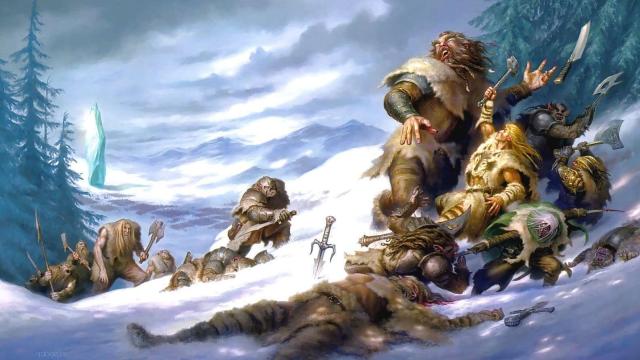In the frozen tundra of novels of yore, where I read these classic fantasy books to see what treasures might still lie within”¦ and what horrors, too.
When I proposed this project to Jill, I always knew I’d have to start with the book that first hooked me as a fantasy-loving, 11-year-old nerd: 1988’s The Crystal Shard. While it’s not the first D&D novel ” nor even the first novel set in the immensely popular, by-the-numbers fantasy world of the Forgotten Realms ” it holds two important distinctions. It was the first-ever novel by the best-selling author R.A. Salvatore, and it introduced arguably the most famous and beloved D&D character of all time, Drizzt Do’Urden.
If you’ve ever read a Dungeons & Dragons novel, there’s a decent chance it included Drizzt. The dark elf who forsook his super-evil, subterranean race (although Wizards is now changing the way D&D plays to combat that stereotype, among others) to become a noble Ranger on the surface world stars in a staggering 34 books, many of which hit the New York Times bestseller list. When I was 11, he was pretty much the coolest fictional character I had ever encountered, and I know I wasn’t the only one; the gods only know how many rip-offs he inspired in D&D players of the late “˜80s and “˜90s.
[referenced url=”https://gizmodo.com.au/2020/06/inside-dungeons-dragons-chilling-new-adventure-rime-of-the-frostmaiden__trashed/” thumb=”https://gizmodo.com.au/wp-content/uploads/2020/06/19/zott79do7icvylyojwmq-235×300.png” title=”Inside Dungeons & Dragons’ Chilling New Adventure, Rime of the Frostmaiden” excerpt=”Pack your bags with as many winter clothes and things to bludgeon giants with as you can, adventurers: Wizards of the Coast has unveiled the latest adventure module for Dungeons & Dragons’ fifth edition. We’re heading off to Icewind Dale to uncover grand mysteries and sinister secrets.”]
While Drizzt ends up overshadowing almost everyone and everything, The Crystal Shard is technically an ensemble piece. There’s Bruenor, a dwarf that hits pretty much every fantasy stereotype, including his desire to reclaim an ancestral home that his people were chased out of after they dug too far and awakened a monster. Next, there’s Regis the halfling, D&D’s equivalent of Hobbits, who is so extremely Hobbit-y all he wants to do is eat and nap. While he does set himself apart a bit by carrying a crystal pendant he can use to charm people, he does get forced into danger and ends up saving the day, Bilbo-style, in the book’s final battle.
It’s not all faded photocopies of Lord of the Rings, though. First, it’s set in the colds of Icewind Dale, specifically around the villages collectively known as Ten-Towns. Second, the fourth member of the party is Wulfgar, a young barbarian Bruenor captures after an assortment of Northern tribes stages a failed attack on Ten-Towns. Although the dwarf does place the barbarian in indentured servitude for five years, by the end of that time Wulfgar is essentially his adopted son, to the point that Bruenor makes Wulfgar a super-badass magic battle hammer that returns to his hand when thrown (so at least Salvatore is doing Thor instead of LotR).
Perhaps the book’s biggest distinction is that its main antagonist, Akar Kessel, is a complete dipshit. He’s introduced as a moron sorcerer’s apprentice who can only barely cast the easiest of spells, who murders his master after some other wizards lied to him that somehow this would earn him a promotion. Instead, the wizards toss him into a ravine of snow, where he chances upon Crenshinibon, the titular shard. It’s an artefact of pure evil that can give its bearers immense power, which Kessel uses to amass a giant army of various monsters which he sends to conquer Ten-Towns. The shard cannot, however, make Kessel any less of a dipshit, and the wizard is defeated by a few lies, a bag of flour, and an avalanche Kessel himself causes. By the end, Crenshinibon is so tired of Kessel’s bullshit it chooses to be buried under tons of snow instead of saving its bearer.

I found Kessel so stupid he became genuinely entertaining, but the book has plenty of other issues. The writing literally spells out everyone’s thoughts, emotions, and motivations at every moment, and every character beyond the main four are almost completely nondescript. Drizzt and Wulfgar are so preternaturally badass they beat 25 giants by themselves (well, with help from Drizzt’s magic panther Guenhwyvar, because of course he has a magic panther pal), while Bruenor and his dwarves managed to somehow kill 1,000 of Kessel’s goblins in a night raid, without them even waking up. At least when Drizzt and Wulfgar take on a white dragon, they have a rough time until Wulfgar notices a giant, impossibly deadly icicle helpfully hanging on top of the cave they’re fighting in.
That’s only the third-worst deus ex machina in the book, unfortunately. Kessel manages to enlist a giant, nearly invincible demon to join his ranks, but Drizzt luckily manages to find a scimitar (his favourite weapon) in the dragon’s treasure hoard, and it ever-so-luckily happens to be able to defeat the demon (who serves no other role in the story than to be beaten by Drizzt). But even that’s not as egregious as the story’s end, when the book retcons that Drizzt took a tiny bag of flour from the giants’ stronghold as a souvenir and uses it to coat Crenshinibon and defeat its light-based mega-magic.
However, The Crystal Shard‘s biggest crime by far is its scarcity of female characters; only one has a name and dialogue. That would be Bruenor’s adopted human daughter Cattie-Brie, who, even though Drizzt calls her his soulmate in chapter one, gets only a few dozen lines. The only other female characters mentioned are fleeing villagers and various “wenches,” and most of those are Kessel’s enslaved harem who die unmentioned and unseen when the villain is defeated and his tower collapses.
Extremely terrible, but I’d be lying if I said I didn’t find the book a little more readable than I thought it would be. Not to gloss over any of its many, many problems, but it moves fast enough there’s not much time to dwell on its technical issues, at least. And whether I’ve softened with age or let my nostalgia get the better of me, I can’t help but see it as the work of a first-time author published in 1998 by TSR, a company that was much more interested in the number of books it could churn out than their quality. Plus, since I read several more Drizzt novels back in the day, I know for a fact that Salvatore’s writing ” included his female characters; thankfully, Cattie-Brie even eventually joins Bruenor, Drizzt, and Wulfgar on their adventures in later books ” improved over time. Given that the 35th instalment (!) of Drizzt’s adventures is due out next month, I’m guessing that’s only continued.
But it’ll be a long, long time before I get there, if at all. Assuming you guys enjoy this, I’ll be reviewing more D&D novels of the “˜80s, including the other two novels in the Icewind Dale trilogy, Streams of Silver and The Halfling’s Gem. I’ll probably stay in Forgotten Realms for a little while, before dipping into the Greyhawk setting (which I know almost nothing about), and then the original Dragonlance trilogy by Margaret Weis and Tracy Hickman, which everyone loved and I’m guessing holds up pretty well.
You cannot say the same for The Crystal Shard. Even though I ended up finding the writing more tolerable than I had suspected, the book is deeply, deeply flawed to say the least. So for my rating, The Crystal Shard rolls a 3 on a 1d20. I don’t know how good any of these D&D novels will ending up being, but I do know there’s a vast, frozen tundra’s worth of room for improvement”¦ and there’s room for worse, too. Like in any good dungeon, treasures and monsters go hand-in-hand.
[referenced url=”https://gizmodo.com.au/2020/06/how-r-a-salvatore-helped-bring-icewind-dale-to-games-again-for-dark-alliance/” thumb=”https://gizmodo.com.au/wp-content/uploads/2020/06/20/hpcvg6kf0gfia2445fpr-e1592776314165-300×144.png” title=”How R.A. Salvatore Helped Bring Icewind Dale to Games Again for Dark Alliance” excerpt=”Later this year, a familiar name to Dungeons & Dragons video game fans is finally making a return with the reboot of Dark Alliance, the beloved hack-n’-slash action RPG series. To do so, it’s bringing in some familiar D&D icons in the form of Drizzt Do’Urden and his legendary friends…”]
Assorted Musings:
- I thought Drizzt was pronounced “Dritz” for many, many years.
- The giants Drizzt and Wulfgar annihilate are specifically Verbeeg, who are basically 3.05 m-tall humans. They don’t look monstrous like regular giants or ogres, but their name is clearly a horrible portmanteau of “very big” so I am fine with them all being murdered.
- Cattie-Brie does have a role in the final battle, and it’s to collapse the dwarves’ tunnels if goblins start entering them. It’s a solo mission, so some of her dialogue is telling Bruenor how she’s not particularly enthused at the thought of burying herself alive.
- The dragon’s name is Icingdeath, which is only slightly more intimidating than Frostingdeath.
- The book introduces Drizzt as having the hots for treasure ” not collecting it, just seeing what riches the foes he slays have on hand. Most Dungeons & Dragons players feel the same way since gold is the closest thing the role-playing game has to points, but it feels weird for a D&D character to share the same vice. I don’t recall this being one of Drizzt’s habits at all, so I assume it gets dropped sooner rather than later?
- During the Verbeeg fight, Wulfgar yells in his native language, “Prayne de crabug ahm keike rinedere be-yogt iglo kes gron!” at Drizzt after the elf teasingly leads a bunch of Verbeeg to the barbarian and hides, forcing him to do the fighting. At the book’s end, Wulfgar reveals it means “May the fleas of a thousand reindeer nest in your genitals.” I thought this was the funniest goddamn thing in the entire world when I was 11. I have come to realise that may not exactly be the case.
- Next time: Azure Bonds!
